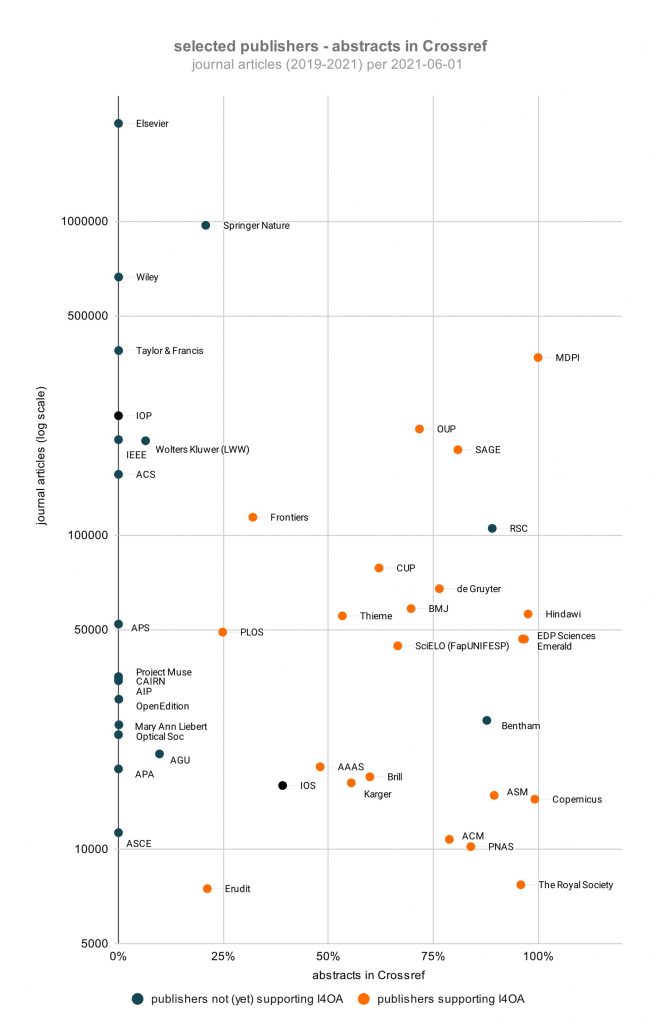When I first heard about the Initiative for Open Abstracts (I4OA), I was curious why we needed such collaboration when we could find abstracts from almost any publisher websites. This article will tell you why.
Making Abstracts Open – Why bother?
As we know, many publishers publish the abstracts of the subscription-based articles in their sites as they help to boost discoverability and draw readers’ attention to purchase those full-text articles behind the paywall. However, we should note that such openness has limitations: These abstracts can be read by human but they are not machine-accessible via application programming interfaces (APIs), and it is also not easy to do web scrapping in some cases. Without machine accessibility, it is difficult to conduct large-scale literature searches for systemic review which becomes very popular in various fields.
I4OA, launched in September 2020, is a collaboration between scholarly publishers, research infrastructure organizations, librarians, researchers, and other interested parties to advocate and promote the unrestricted availability of the abstracts of the world’s scholarly publications in open infrastructures. I4OA is leading the way with expanding the availability of abstracts. At the very beginning, 40 publishers agreed and showed their support. Now one year on, over 80 publishers of both subscription-access and open-access academic journals and books have joined the initiative.
Open Infrastructure for Machine-Accessibility – Why Crossref?
Databases such as Scopus, Web of Science, and PubMed indeed provide access to abstracts. Yet these databases have various limitations such as paywall, data-scraping restrictions, or limited disciplinary coverage (e.g. focusing on Sci-Tech/medicinal fields). Extracting and analyzing messy and inconsistent abstracts from various sources can be very time-consuming and counter-productive.
As a result, by making abstracts open, I4OA particularly calls on scholarly publishers to open their abstracts in an open infrastructure, and whenever possible to deposit them together with all their DOI registration metadata with Crossref. You may ask why Crossref then? Crossref is a not-for-profit organization, a Digital Object Identifier (DOI) registration agency of the International DOI Foundation, which provides content registration service for publishers. The abstracts in Crossref are clean and well-formatted, and they are searchable and API accessible with minimal restrictions. The figure below shows publisher statistics on the number of open abstracts in Crossref as of Jun 2021. We can see major publishers such as Elsevier, Springer Nature, and Wiley still have not deposited abstracts openly to Crossref yet. If you are interested to see each individual publisher’s metadata sharing status, please check at Crossref’s Participation Reports.

Figure: Selected publisher statistics on openness of abstracts (Source: I4OA Twitter)
Investment on open abstracts fuels the development of future generations of open-science search tools and it lends itself well to accelerate research discoveries. By harvesting machine-readable open abstracts, free discovery services such as Lens.org and dimensions.ai can provide more relevant and precise search results to their users. Furthermore, open abstract metadata provides better coverage for discovery and enables potential data-mining processes which can be used for data visualization such as VOSviewer and Open Knowledge Map.
References
Initiative for Open Abstracts (n.d.). Frequently asked questions. Initiative for Open Abstracts. https://i4oa.org/faqs.html
Tay, Aaron; Kramer, Bianca; and Waltman, Ludo (2020). Why openly available abstracts are important — overview of the current state of affairs. Academic Librarians and open access.
– By Samson Choi, Library
Hits: 137
Go Back to page Top
- Category:
- Academic Publishing
Tags: Crossref, I4OA, Open Abstracts, Open Science
published September 15, 2021
last modified March 11, 2022


